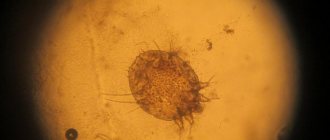Ophthalmologist, Laser ophthalmic surgery
Karapetyan
Arevik Samvelovna
8 years of experience
Ophthalmologist
Make an appointment
Acute purulent inflammation in the hair follicle of the eyelash or in the sebaceous gland is called “barley” because of its characteristic round shape, reminiscent of grain. The external harmlessness of this phenomenon is deceptive: it clearly indicates a decrease in the protective properties of the immune system and requires careful treatment to prevent relapses and possible complications.
Causes of stye on the eye
Staphylococci, which prefer to settle on human skin and hair, do not manifest themselves in any way with strong immunity. Their intensive reproduction is triggered by a decrease in the protective properties of the body, its hypothermia, severe illnesses and hypovitaminosis, and the consequences of helminthic infestation. Penetrating into the structure of the hair follicle, streptococci cause inflammation and suppuration as a reaction to a pathogenic microorganism. This is the main cause of stye on the eye in patients of all ages. With an unbalanced diet, increased physical activity or stressful situations, the disease can occur in the form of several or multiple suppurations on the eyelids or mucous membranes. Also among the factors contributing to the appearance of stye on the eye is the habit of touching the eyelids with dirty hands, a large amount of dust indoors or outdoors.
The risk group for the likelihood of the appearance of barley includes:
- patients with reduced immunity;
- persons with diseases of the endocrine system;
- patients with gastrointestinal pathologies;
- persons whose professional activities involve working outdoors or in premises with difficult climatic or unsanitary conditions;
- patients who have suffered inflammatory diseases of the eyes and eyelids, as well as those who have not completed the prescribed course of treatment.
At-risk groups
Barley, according to statistics, is more common in women and children. The former are susceptible to illness due to frequent use of cosmetics, which allows pathogenic microorganisms to penetrate into the tissues. This happens when using dirty or excessively hard brushes or sponges, low-quality or damaged cosmetics.
Children often do not fully observe the rules of hygiene: they rarely wash their hands, rub their eyes and eyelids with dirty fingers, and neglect regular washing. Another category of people susceptible to the disease are older people, often with chronic diseases and poor health.
Symptoms of stye on the eye
Suppuration of the eyelid makes itself felt by a feeling of heaviness, swelling and inflammation along the eyelash line. The area becomes painful, the temperature of the skin of the eyelids rises. The line of edema has clear boundaries; signs of hyperemia are noticeable on the conjunctiva - redness and inflammation. Within 2-3 days from the moment the barley develops, a purulent head forms on its surface, the contents of which are dead cells of the hair follicle.
With internal barley, the pathology is localized in the area under the eyelid - in the so-called meibomian gland, which makes the disease almost invisible. The inflammatory process is indicated by the characteristic symptoms of stye - thickening and soreness of the affected eyelid. The danger of such a disease is the development of chalazion - inflammation of the cartilage around the meibomian gland, which significantly delays the healing process and forces the patient to undergo regular examinations by an ophthalmologist.
In severe cases, with barley localized inside the sebaceous gland, signs of general intoxication are observed - headache and muscle pain, fever, swollen lymph nodes. Self-medication in this case is strictly contraindicated, and the patient should immediately seek medical help.
Are you experiencing stye symptoms?
Only a doctor can accurately diagnose the disease. Don't delay your consultation - call
Complications
The contents of ripened barley should never be squeezed out yourself. Otherwise, infection may enter the subcutaneous veins of the face, and through them into the deep veins of the orbit. In the future, multiple abscesses of the eyelid, phlegmon of the orbit, thrombophlebitis of the orbital eyelids, and in especially severe cases, purulent meningitis and sepsis with a fatal outcome may develop.
Untreated barley leads to chronic infection and relapse of inflammation; A complication of internal stye can be a chalazion, requiring surgical treatment.
Types and stages of development of barley
Depending on the location and external signs there are:
- External stye is a painful formation on the eyelash line that quickly festeres. Signs of barley in this case are visible to the naked eye, which simplifies the diagnosis;
- internal barley - localized inside the eyelid, causing discomfort due to severe pain and the feeling of a foreign object in the eye. It is detected during a visual medical examination.
The formation and development of barley occurs in several stages:
- infiltration process. The first characteristic signs of suppuration appear: itching, swelling, redness of the eyelid in the area of inflammation. Over the course of several hours, the discomfort intensifies;
- process of suppuration. A capsule with purulent contents is visible on the surface of the formation. With an increase in the volume of pus or mechanical impact, it may break out prematurely;
- the process of breakthrough of the purulent capsule. If the inflammation does not break out on its own, it is opened by a surgeon. Separation of purulent contents occurs within several days;
- healing. A crust forms at the site of the ulcer, under which a thin layer of restored skin forms. Depending on the quality of the course of treatment and the state of the immune system, the healing period can range from several days to several weeks.
Complications of stye on the eye
The importance of seeing a doctor when barley appears is due to the high risk of developing the following complications:
- conjunctivitis is an infectious lesion of the mucous membrane of the eye, causing swelling, hyperemia and some blurring of vision. Treatment of the disease is complex and lengthy;
- Chalazion is a cystic formation on the inside of the eyelid. Causes inconvenience and requires long-term treatment;
- phlegmon of the orbit - caused by profuse suppuration due to an attempt to independently open the stye or multiple formation of foci of suppuration with their subsequent fusion. Symptoms of this pathology are blurred vision, severe swelling, discomfort when moving the eyelid, etc.;
- thrombosis of the vascular plexus - a violation of the outflow of fluid from the orbit, which causes swelling. The eyeball protrudes, the skin turns blue, the eyelids become inflamed, and vision deteriorates sharply;
- thrombophlebitis is an inflammatory process in blood vessels. Characterized by headache, feeling of fatigue, decreased visual acuity, redness of the eye mucosa;
- meningitis - consequences of phlegmon of the eye. Signs of a deadly pathology: temperature above 39°C and severe headache;
- sepsis is blood poisoning due to the ingress of pus and pathogenic microorganisms into it. Signs of complications: intoxication of the body, chills, rapid heartbeat, rash, breathing problems.
What's really going on?
Barley is an acute, purulent clinical, infectious inflammatory process in origin. From this exhaustive definition, the reasons for its appearance, patterns of development, and the choice of adequate treatment and preventive measures clearly follow.
In the vast majority of cases, hordeolum is caused by the introduction of a bacterial (more precisely, Staphylococcal aureus) infection with subsequent rapid proliferation of the pathogen in the hair follicles, glands of Moll and/or Zeiss, less often in the meibomian glands (in this case, the “internal” barley is turned by the fistula canal towards the conjunctiva ).
Constant, often recurrent styes in a child always indicate the presence of some hidden or obvious systemic pathology. Usually this is a decrease in immunity due to an incorrect, unnatural lifestyle for children (physical inactivity, lack of sunlight, fresh air, etc.), hypovitaminosis, endocrine or gastroenterological disorders, recent diseases or operations, and the presence of worms.
Hypothermia and overheating, untreated or undertreated infectious foci, for example, in the oral cavity or nasopharynx (caries, tonsillitis, etc.) contribute to the development of stye.
But the main factor that makes styes a global problem and an almost inevitable companion to childhood is children's curiosity, combined with unwashed hands and a lack of strong sanitation and hygiene skills.
The crowding of children's preschool and school groups, the use of common towels or pillows, the habit of examining everything, so to speak, by palpation, the reflexive impulse to intensively rub the eyes in case of any discomfort - all this creates extremely favorable conditions for the spread of staphylococcal infection.
In addition, adults make a significant contribution to increasing the adaptability and survival of staphylococcus: uncontrolled and inadequate use of antibiotics leads to mutations and the formation of drug-resistant bacterial strains.
Treatment of barley
With strong immunity, the disease can go away on its own without special treatment. This happens if the adverse effects on the body have stopped and the activation of staphylococcus has been suppressed.
Self-treatment of stye on the eye with medications at home is not recommended. Moreover, folk recipes often pose a threat to vision. Tips on how to treat stye can cause rupture of the purulent capsule and infection of the eye mucosa with the most serious consequences.
A course prescribed by a specialist will be many times more effective and safer. Its components are antibacterial drugs, local antibiotics and compounds for relieving the inflammatory process. Treatment of barley should be carried out under supervision and based on the recommendations of a specialist. If a complication develops, he will immediately correct the course and take measures to prevent further inflammation.
Prevention of stye
The following will help eliminate the risk of stye:
- compliance with personal hygiene rules;
- measures to strengthen the body's defenses and restore immunity;
- eliminating situations of overheating or hypothermia of the body;
- timely treatment of serious infectious diseases;
- active lifestyle;
- balanced diet, taking vitamin courses.
Additional recommendations taking into account the patient’s body condition will be given by the attending physician.
Is it possible to get infected with stye?
If someone has a stye on their eye, can they get it? The main pathogen, Staphylococcus aureus, is easily transmitted by contact, airborne droplets, household and other means, but almost the entire population of the planet has already been infected with these pathogenic microorganisms, just few people know about carriage due to the lack of symptoms.
The stye itself, which is very important to treat, can theoretically be transmitted, but for infection, pus or particles of the patient’s tissue must get onto the eyelid or into the eye of a healthy person, which is practically impossible in life. So there is no need to worry about infection if you notice symptoms of hordeolum in other people.
Questions and answers
What causes stye on the eye?
The main cause of inflammation is infection of the sebaceous gland or hair follicle of the eyelash due to the active activity of staphylococci. This is facilitated by air pollution, a decrease in the protective properties of the immune system, and non-compliance with personal hygiene rules. Less commonly, stye appears on the eye due to difficult professional conditions or untreated infectious eye diseases.
How does stye appear?
The first signs of stye are discomfort of the eyelid, noticeable inflammation and swelling of the eyelash area, itching and a feeling of some heaviness. Within a few days, a yellow, purulent head of inflammation becomes noticeable on the surface of the skin. As it matures, it breaks through, after which a number of “inflammatory” symptoms of the disease go away, but a slight itching and an area of redness remain.
How to quickly remove stye from the eye?
Any methods of treating stye should be agreed upon with an ophthalmologist. The sooner you seek help, the faster you will be able to cope with the pathology. Antibacterial agents and topical ointments will help speed up the breakthrough of the purulent capsule. Attempts to quickly remove stye from the eye with compresses, heating or squeezing out pus are very dangerous and can cause serious inflammation of the mucous membrane and damage to the eyeball.
Classification
Barley varies in type and location. According to this classification, the following types of inflammation are distinguished:
- External. The infection develops in the ciliary bulb or sebaceous gland of Zeiss. Because of this, inflammation forms at the edge of the eyelid.
- Internal. Bacteria collect in the passage of the meibomian glands, leading to their irritation. In this case, barley forms on the eyelid from the inside.
- Hot. Short-term inflammation that resolves within a week. In this case, barley forms in the eyelash pocket.
- Cold. Characterized by damage to the passage of the meibomian glands. Inflammation develops over several months and involves the cartilage of the eyelid. The subcutaneous seal is large in size and resembles a bone.
Another name for cold stye is chalazion. If it puts pressure on the eyeball, it must be removed. Under more favorable circumstances, the chalazion may resolve on its own.
Prevention
In order not to find out what hordeolum looks like, not to treat or even figure out how to cure barley, prevent its development and the occurrence of unpleasant symptoms. Observe the following preventive measures:
- Promptly treat any systemic diseases in the early stages of their development.
- Stop using contact lenses for a while if your eye begins to look sore and red.
- If you notice any symptom affecting the organs of vision (the eye begins to look inflamed), contact an ophthalmologist. He will make a diagnosis, find out its causes and cure the detected disease.
- Do not try to treat emerging illnesses at home. A doctor will treat you better and faster.
- Do not try to eliminate any unpleasant symptom on your own by taking medicine without a doctor's prescription.
- Take care of your health. Such care should look like giving up destructive habits, following a daily routine, moderate physical activity, and a balanced diet.
- Maintain good hygiene.
Having discovered at least one symptom of barley, you should begin to treat it. Contact a specialist, get diagnosed and start taking the prescribed medication.
Diagnostic measures
Before you begin to treat eye stye, you should confirm the diagnosis, understand what caused the inflammation, and identify concomitant diseases. To detect and cure the disease, you should consult an ophthalmologist who will prescribe the following diagnostic procedures:
- conducting a visual external examination with palpation of the eyelid and everting it (if the symptom manifests itself on the inside);
- ophthalmoscopy with examination of the main elements of the eye structure;
- biomicroscopy - examination of the anterior parts of the eyes using a special microscope with a slit lamp;
- bacterial culture of purulent discharge to identify the pathogen;
- blood tests: general and clinical, for infections and hormones.
The doctor will be able to effectively treat and successfully cure the disease only with a competent and timely diagnosis. And therefore, if you notice at least one symptom (even if it does not look serious), you should immediately visit a specialist and undergo a comprehensive diagnosis.










